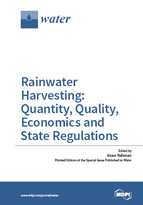Rainwater Harvesting: Quantity, Quality, Economics and State Regulations
A special issue of Water (ISSN 2073-4441). This special issue belongs to the section "Water Resources Management, Policy and Governance".
Deadline for manuscript submissions: closed (28 February 2017) | Viewed by 119426
Special Issue Editor
Interests: hydrology; rainfall runoff; rainwater harvesting; flood; water demand forecasting; water sensitive urban design; water quality
Special Issues, Collections and Topics in MDPI journals
Special Issue Information
Dear Colleagues,
Rainwater harvesting (RWH) is the most popular alternative water source in many urban, peri-urban, and rural areas. Although rainwater is fresh in nature, it gets polluted from atmospheric contaminants, roof catchments, and the RWH system itself. The research questions which are the most relevant to RWH system include the optimum rainwater tank size for a given location and set of users, water quality from a RWH system, financial viability of a RWH system, and state regulations on the use of water from a RWH system. You are invited to submit a technical paper to this Special Issue of Water on these aspects of a RWH system.
Dr. Ataur Rahman
Guest Editor
Manuscript Submission Information
Manuscripts should be submitted online at www.mdpi.com by registering and logging in to this website. Once you are registered, click here to go to the submission form. Manuscripts can be submitted until the deadline. All submissions that pass pre-check are peer-reviewed. Accepted papers will be published continuously in the journal (as soon as accepted) and will be listed together on the special issue website. Research articles, review articles as well as short communications are invited. For planned papers, a title and short abstract (about 100 words) can be sent to the Editorial Office for announcement on this website.
Submitted manuscripts should not have been published previously, nor be under consideration for publication elsewhere (except conference proceedings papers). All manuscripts are thoroughly refereed through a single-blind peer-review process. A guide for authors and other relevant information for submission of manuscripts is available on the Instructions for Authors page. Water is an international peer-reviewed open access semimonthly journal published by MDPI.
Please visit the Instructions for Authors page before submitting a manuscript. The Article Processing Charge (APC) for publication in this open access journal is 2600 CHF (Swiss Francs). Submitted papers should be well formatted and use good English. Authors may use MDPI's English editing service prior to publication or during author revisions.
Keywords
- rainwater
- rainwater harvesting
- alternative water supply
- rainwater quality
- water cycle management
- rainwater economics
- water regulations






